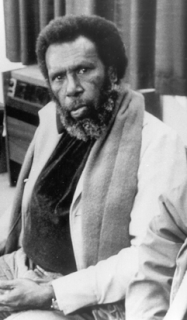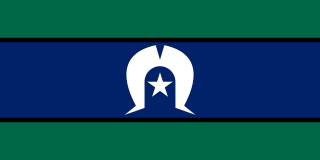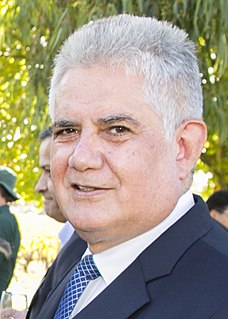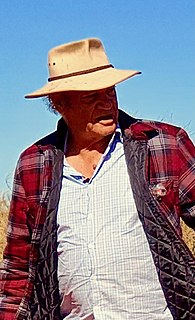
Edward Koiki Mabo was an Indigenous Australian man from the Torres Strait Islands known for his role in campaigning for Indigenous land rights in Australia, in particular the landmark decision of the High Court of Australia that overturned the legal doctrine of terra nullius that had previously characterised Australian law with regard to land and title. High court judges considering the case Mabo v Queensland found in favour of Mabo, which led to the Native Title Act 1993 and established native title in Australia, officially recognising the rights of Aboriginal and Torres Strait Islander people in Australia to own and use the land on which their families had lived for millennia.

The National Museum of Australia, in the national capital Canberra, preserves and interprets Australia's social history, exploring the key issues, people and events that have shaped the nation. It was formally established by the National Museum of Australia Act 1980.

Torres Strait Islanders are the Indigenous peoples of the Torres Strait Islands, which are part of the state of Queensland, Australia. Ethnically distinct from the Aboriginal people of the rest of Australia, they are often grouped with them as Indigenous Australians. Today there are many more Torres Strait Islander people living in mainland Australia than on the Islands.

The Australian Aboriginal Flag represents Aboriginal Australians. It is one of the officially proclaimed flags of Australia, by which it has special legal and political status together with the national flag and the Torres Strait Islander Flag, with which it is often flown.

The Torres Strait Islander Flag is an official flag of Australia, and is the flag that represents Torres Strait Islander people. It was designed in 1992 by Bernard Namok. It won a local competition held by the Islands Coordinating Council, and was recognised by the Aboriginal and Torres Strait Islander Commission in June 1992.
The Australia Council for the Arts, commonly known as the Australia Council, is the country's official arts council, serving as an arts funding and advisory body for the Government of Australia. The council was announced in 1967 as the Australian Council for the Arts, with the first members appointed the following year. It was made a statutory corporation by the passage of the Australia Council Act 1975.
The National Aboriginal & Torres Strait Islander Art Award (NATSIAA) is Australia's longest running Indigenous art award. Established in 1984 as the National Aboriginal Art Award by the Museum and Art Gallery of the Northern Territory in Darwin, the annual award is commonly referred to as the Telstra National Aboriginal & Torres Strait Islander Art Award, the Telstra Award or Telstra Prize. It is open to all Aboriginal and Torres Strait Islander artists working in all media.

The Bidjigal people are an Aboriginal Australian people whose traditional lands are modern-day western, north-western, south-eastern, and southern Sydney, in New South Wales, Australia. The land includes the Bidjigal Reserve, Salt Pan Creek and the Georges River. They are part of the Dharug language group, and there is debate as to whether the clan is part of the Dharug or Eora people.
The Tandanya National Aboriginal Cultural Institute, usually referred to as Tandanya, is an art museum located on Grenfell Street in Adelaide, South Australia. It specialises in promoting Indigenous Australian art, including visual art, music and storytelling. It is the oldest Aboriginal-owned and -run cultural centre in Australia.

Makinti Napanangka was a Pintupi-speaking Indigenous Australian artist from Australia's Western Desert region. She was referred to posthumously as Kumentje. The term Kumentje was used instead of her personal name as it is customary among many indigenous communities not to refer to deceased people by their original given names for some time after their deaths. She lived in the communities of Haasts Bluff, Papunya, and later at Kintore, about 50 kilometres (31 mi) north-east of the Lake MacDonald region where she was born, on the border of the Northern Territory and Western Australia.
Danie Mellor is an Australian artist who was the winner of the 2009 National Aboriginal & Torres Strait Islander Art Award. Born in Mackay, Queensland, Mellor grew up in Scotland, Australia, and South Africa before undertaking tertiary studies at North Adelaide School of Art, the Australian National University (ANU) and Birmingham Institute of Art and Design. He then took up a post lecturing at Sydney College of the Arts. He works in different media including printmaking, drawing, painting, and sculpture. Considered a key figure in contemporary Indigenous Australian art, the dominant theme in Mellor's art is the relationship between Indigenous and non-Indigenous Australian cultures.

Bill Yidumduma Harney is an elder of the Wardaman people, known as an artist, storyteller, and musician. As of 2009 he was living at Menngen Station, near Katherine in the Northern Territory of Australia, which lies in the traditional lands of the Wardaman people.

Kenneth George Wyatt is an Australian politician who has been a member of the House of Representatives since 2010, representing the Division of Hasluck for the Liberal Party. He is the first Indigenous Australian elected to the House of Representatives, the first to serve as a government minister, and the first appointed to cabinet. Wyatt was appointed Minister for Aged Care and Minister for Indigenous Health in the Turnbull Government in January 2017, after previously serving as an assistant minister since September 2015. He was elevated to cabinet in May 2019 as Minister for Indigenous Australians in the Morrison Government.
Tjayanka Woods is an Australian Aboriginal artist. She was one of the pioneers of the art movement across the Ngaanyatjarra, Pitjantjatjara and Yankunytjatjara lands, which began in 2000. She is best known for her paintings, but also a craftswoman who makes baskets and other woven artworks. Her paintings are held in the Art Gallery of Western Australia, National Gallery of Victoria, and the National Gallery of Australia.

Vincent Forrester is an Aboriginal Australian activist, artist and community leader. Forrester was a founding member of a number of Aboriginal organisations in central Australia. He lives at Mutitjulu, where he has served as the chairman of the community council. During the 1980s, he served as an advisor on indigenous affairs to the governments of Malcolm Fraser and Bob Hawke.
Tiger Palpatja was an Australian Aboriginal artist from the Aṉangu Pitjantjatjara Yankunytjatjara Lands.
Banduk Mamburra Wananamba Marika was an artist and printmaker from Arnhem Land, Northern Territory, Australia. She was a member of the Rirratjingu clan of the Yolngu people, whose traditional land is Yalangbara. She was also an environmental activist and leader, and the first Aboriginal person to serve on the National Gallery of Australia's board.

Andrew James Bragg is an Australian politician who was elected as a Senator for New South Wales at the 2019 federal election. He is a member of the Liberal Party. A member of several committees related to finance and technology, Bragg advocates changes to the Australian retirement system and supports the 2017 Uluru Statement from the Heart.
Barbara Mbitjana Moore is an Anmatyerre woman who grew up in Ti-Tree in the Northern Territory, moving later to Amata in South Australia's Anangu Pitjantjatjara Yankunytjatjara (APY) Lands. In April 2003, Moore began painting at Amata's Tjala Arts, and, since then, has received widespread recognition. Moore won a National Aboriginal & Torres Strait Islander Art Award in 2012 and has been a finalist in many other years. Moore has also been a finalist for the Wynne Prize.
Alick Tipoti, whose traditional name is Zugub, is a Torres Strait Islander artist, linguist, and activist of the Kala Lagaw Ya people, from Badu Island, in the Zenadh Kes. His work includes painting, installations, printmaking, sculpture and mask-making, and is focused on preserving the culture and languages of his people.












